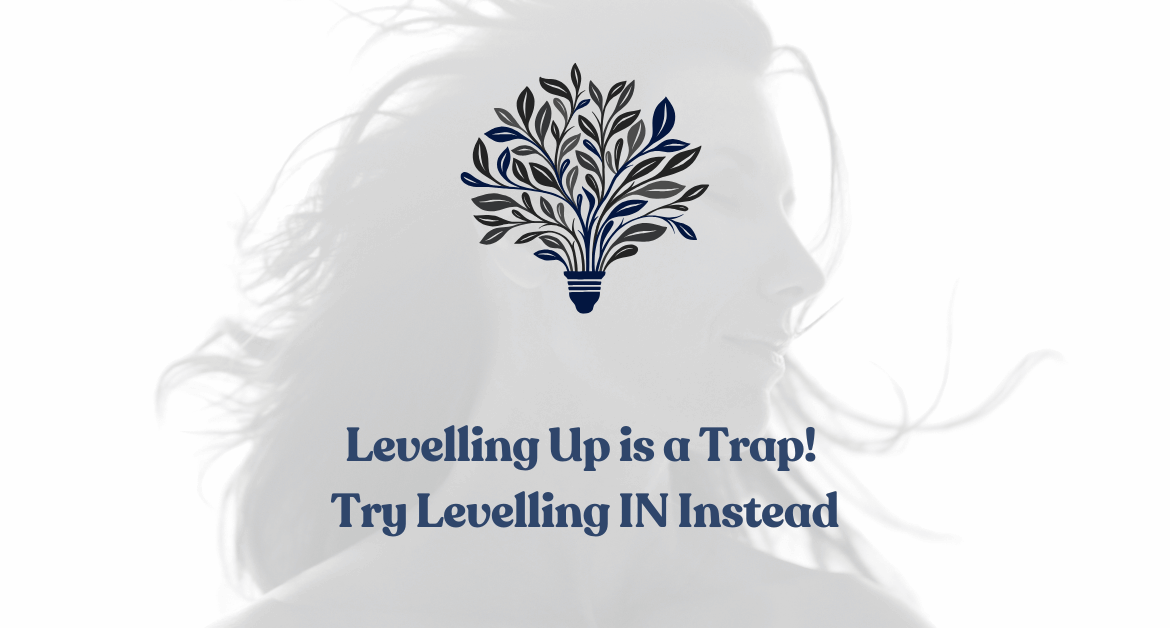

Levelling Up is a Trap!
“The world tells you to climb higher. I say: stop reaching.”
madelaine vallin
🎧 Prefer to listen?
Here’s the read-aloud version of this article:
I bought into it—the myth that growth meant climbing. That levelling up was the goal. More success. More productivity. More purpose. More proof that I was doing life right.
I spent years chasing the next level, believing that if I just pushed a little harder, stretched a little further, I’d finally get there. But I never arrived. Because the truth is, there’s no arriving when the only direction you know is up.
We live in a culture obsessed with levelling up. It sells us the story that growth is a ladder, that progress means climbing. And yet—what happens when you reach the top and still feel hollow? What happens when your whole life becomes a performance of growth—and no one ever tells you that rest is also transformation?
That’s where I broke. Quietly. I didn’t shatter—I crumbled in the way tired things do. Slowly. Invisibly. At the time, I told myself I was just “between projects.” But really, I was empty. Not uninspired—just spent. Burnt from the inside out.
And that’s when I started learning what no one had ever taught me: real growth isn’t about going higher. It’s about going deeper. It’s not about levelling up. It’s about levelling in.
“Growth isn’t in the next level—it’s in the depth you’ve been avoiding.”
Levelling in is the kind of growth no one talks about. It’s not shiny. It won’t get you applause. No one hands out trophies for stillness, integration, or emotional depth. It’s the kind of growth that feels uncomfortable, because it doesn’t always look like progress. But it’s the only kind that creates anything real.
Levelling in is what happens when you stop chasing and start inhabiting. When you stop asking “What’s next?” and start asking “What’s here?” It’s what happens when you finally sit with what’s inside you instead of trying to outrun it.
It’s not about stagnation—it’s about presence. It’s slowing down when the world tells you to speed up. It’s pausing, intentionally, when your old self wants to bolt. It’s not passive. It’s brave.
“I used to resist the winter inside me. Now, I lean into it.”
I come from a place where winter stretches long and silence has edges. The cold isn’t an enemy there—it’s a teacher. You learn that slowing down isn’t stopping. It’s preparing. The birch tree doesn’t rush its next leaf. The forest doesn’t weaken in winter. It gathers. It holds. It waits. And that’s the lesson I was missing.
I used to resist the winter inside me. Now, I lean into it. Because I’ve seen what emerges when I stop forcing. There’s something wise in the pause. Something ancient. It says: you don’t need to push—just listen. It’s the sound of life still happening, even in the quiet.
We’re not designed for endless output. We’re built for rhythm. The nervous system isn’t wired for constant acceleration—it functions in waves. Expansion. Contraction. Expression. Integration. This is how we build strength: not by staying “on,” but by moving in cycles.
Modern neuroscience supports what many ancient cultures already knew: growth is not linear. It requires space. The mind needs time to process, the body needs time to regulate, the spirit needs time to re-root. Without these pauses, we lose connection to ourselves. We become brittle. Fragile. Numb.
True resilience doesn’t come from pushing—it comes from aligning. And alignment can’t be rushed.
But the world will resist this idea—and so will you.
Because levelling in won’t get you noticed. It won’t show up on a timeline. No one celebrates the quiet work. You won’t get likes for saying, “I slowed down. I stopped forcing. I went inward.”
You’ll want to explain yourself. Justify. Make it sound like a strategy. But it’s not a strategy. It’s a return.
Because this is where everything lives. The clarity. The shift. The you that you’ve been chasing. The version of you you keep trying to become.
Levelling in won’t look like the kind of growth you were taught to chase.
It’s not loud. It’s not linear. It’s not always easy to explain.
But it’s real. It’s steady. And it changes everything.
Levelling up is what’s expected.
Most people will chase. Most people will climb.
Levelling in?
That takes trust.
That takes presence.
That takes nerve.
References
Porges, S. W. (2017). The pocket guide to the polyvagal theory: The transformative power of feeling safe. W.W. Norton & Company.
Siegel, D. J. (2020). The developing mind: How relationships and the brain interact to shape who we are. Guilford Press.

